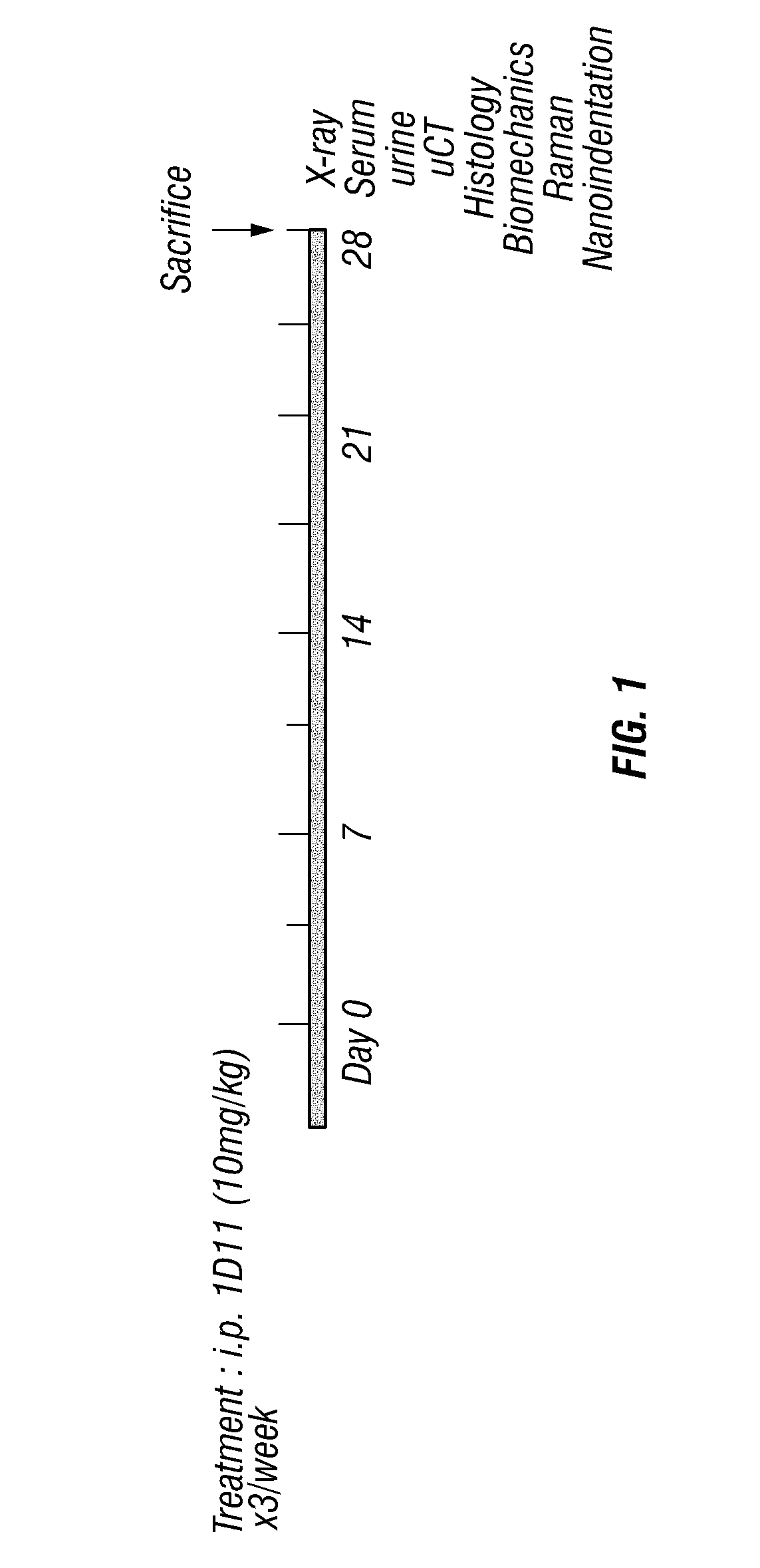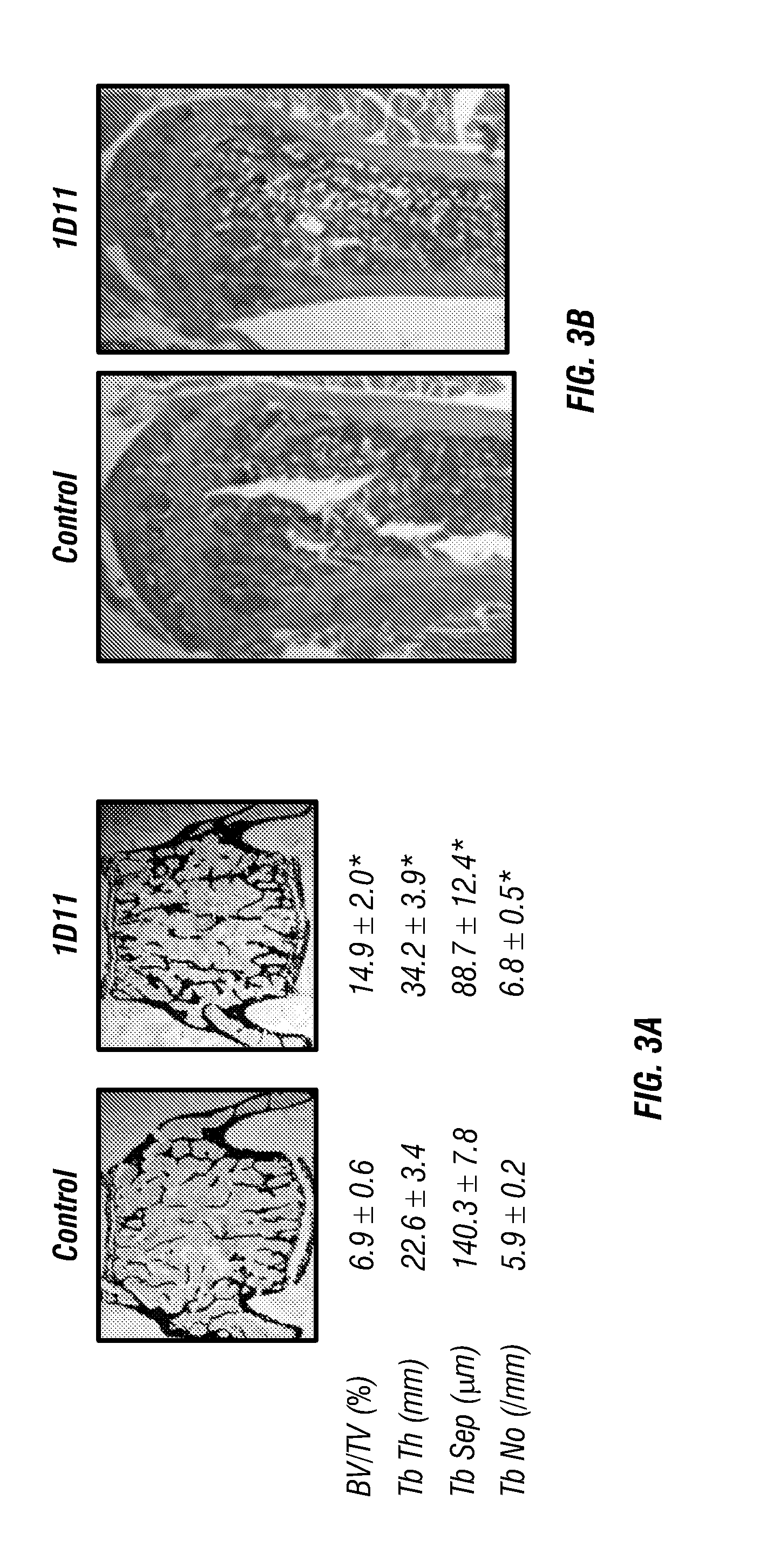Anti-tgf-beta induction of bone cell function and bone growth
a technology of bone cell function and induction of tgfbeta, which is applied in the field of molecular biology and medicine, can solve the problems of hardly the best approach to therapy, structural instability, failure to repair defects, etc., and achieve the effect of increasing bone mass and/or volum
- Summary
- Abstract
- Description
- Claims
- Application Information
AI Technical Summary
Problems solved by technology
Method used
Image
Examples
example 1
Materials & Methods
[0140]Antibodies.
[0141]The 1D11 antibody was generated by Genzyme Corporation (Framingham). Control antibody (13C4) consistent of an identical IgG complex lacking any TGF-β binding capabilities.
[0142]Treatment Regimen.
[0143]Normal 13-week old male C57Bl / 6 mice (Harlan) (n=5) were treated with 10 mg / kg / ×3 week of 1D11 or control antibody. Each reagent was administered by sterile intra-peritoneal injection over a 4 week time period (FIG. 1). All animal procedures were conducted in accordance with IACUC protocols approved by Vanderbilt University Medical Center.
[0144]Imaging.
[0145]Tibia and femure were analyzed by μCT scanning (μCT40, Scanco) at an isotropic voxel size of 12 μm (55Kv). After the growth plate was identified in each scan set, the metaphyseal region 200 μm below this area was scanned and analyzed for alterations in trabecular bone parameters (Threshold 280).
[0146]Histology and Histomorphometry.
[0147]Lumbar vertebral bodies (L3-5) and long bones were col...
example 2
Results
[0162]Inhibition of TGF-β by 1D11 antibody treatment, outlined in FIG. 1, significantly increased long bone volume compared to controls (FIGS. 2A-B). Trabecular bone at the tibial metaphysis analyzed by μCT scanning showed a dramatic increase in overall BV / TV (FIG. 2C), bone mineral density (BMD) (FIG. 2D), trabecular thickness (FIG. 2F) and decreased trabecular separation (FIG. 2F) in animals treated with 1D11 compared to control-treated mice. Histomorphometric analysis of undecalcified sections from lumbar vertebra supported μCT analysis of long bones. 1D11-mediated TGF-β inhibition led to a 54% increase in trabecular BV / TV. This increase in bone was accompanied by greater trabecular number, decreased trabecular separation and increased trabecular thickness (FIGS. 3A-B).
[0163]An analysis of bone cell distribution in TRAP-stained vertebral sections showed significantly reduced osteoclast numbers and surface area following 1D11 treatment (FIGS. 4A-C). In contrast, elevated os...
example 3
Discussion
[0166]This study investigates the use of a TGF-β neutralizing antibody as an anabolic bone agent and highlights the potential of TGF-β inhibition as a mechanism to increase bone mass. The inventors employed standard, accepted techniques along with emerging technologies to thoroughly analyze bone volume, density, strength and composition. Together, these studies demonstrate that drugs aimed at blocking the TGF-β signaling pathway have the capacity to positively regulate osteoblast numbers while simultaneously decreasing the amount of active osteoclasts in the marrow. This results in a profound increase in bone volume and quality, similar to that seen in PTH-treated rodent studies (Dempster et al., 1993).
[0167]There is a considerable need for more efficacious bone anabolic agents. Currently, the major therapeutic approach to excessive bone loss is through the use of anti-resorptives such as bisphosphonates. While these agents are certainly capable of repressing further bone ...
PUM
| Property | Measurement | Unit |
|---|---|---|
| time period | aaaaa | aaaaa |
| isotropic voxel size | aaaaa | aaaaa |
| time | aaaaa | aaaaa |
Abstract
Description
Claims
Application Information
 Login to View More
Login to View More - R&D
- Intellectual Property
- Life Sciences
- Materials
- Tech Scout
- Unparalleled Data Quality
- Higher Quality Content
- 60% Fewer Hallucinations
Browse by: Latest US Patents, China's latest patents, Technical Efficacy Thesaurus, Application Domain, Technology Topic, Popular Technical Reports.
© 2025 PatSnap. All rights reserved.Legal|Privacy policy|Modern Slavery Act Transparency Statement|Sitemap|About US| Contact US: help@patsnap.com



